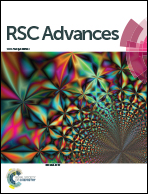A theoretical study on the formation and oxidation mechanism of hydroxyalkylsulfonate in the atmospheric aqueous phase
Abstract
Hydroxymethanesulfonate (HMS) is an important organosulfur compound in the atmosphere. In this work, we studied the formation mechanism of HMS via the reaction of formaldehyde with dissolved SO2 using the quantum chemistry calculations. The results show that the barrier (9.7 kcal mol−1) of the HCHO + HSO3− reaction is higher than that (1.6 kcal mol−1) of the HCHO + SO32− reaction, indicating that the HCHO + SO32− reaction is easier to occur. For comparison, the reaction of acetaldehyde with dissolved SO2 also was discussed. The barriers for the CH3CHO + HSO3− reaction and CH3CHO + SO32− reaction are 16.6 kcal mol−1, 2.5 kcal mol−1, respectively. This result suggests that the reactivity of HCHO with dissolved SO2 is higher than that of CH3CHO. The further oxidation of CH2(OH)SO3− and CH3CH(OH)SO3− by an OH radical and O2 shows that the SO5˙− radical can be produced.



 Please wait while we load your content...
Please wait while we load your content...